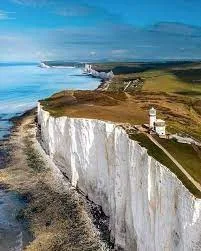The White Cliffs of Dover, soaring along England’s southeastern coast in Kent, are a breathtaking natural wonder where towering chalk formations meet the English Channel. Rising up to 350 feet (110 meters) above the sea, their brilliant white faces, capped with vibrant green fields, create a striking contrast against the deep blue waters below. This iconic landscape, both a geological marvel and a cultural symbol, evokes a dreamlike beauty that has captivated travelers, poets, and artists for centuries.
A Geological Masterpiece

Formed over 70–100 million years ago during the Cretaceous period, the Cliffs of Dover are composed of chalk (calcium carbonate) derived from the fossilized remains of microscopic marine algae called coccoliths. Layers of flint, a hard silica, streak the cliffs, adding texture to their gleaming surfaces. Stretching 8 miles (13 km) along the coast, from Dover to Deal, the cliffs reach their highest point at Langdon Cliffs. Erosion by waves and weathering sculpts their near-vertical faces, while the chalk’s purity gives them their dazzling white hue, visible even from France’s Calais coast on clear days.
The cliffs’ vibrant green crown comes from the rolling fields of the Kent Downs, an Area of Outstanding Natural Beauty. These grassy expanses, dotted with wildflowers like orchids and thrift, thrive on the chalky soil, creating a vivid contrast with the azure sea below. The interplay of white, blue, and green crafts a scene that feels almost surreal, as if painted from a dreamscape.

A Cultural and Historical Icon
Beyond their natural splendor, the Cliffs of Dover hold deep cultural significance. Often called England’s “front door,” they were the first sight for returning sailors and soldiers, symbolizing home and resilience. During World War II, their strategic position above Dover’s port made them a beacon of defiance, immortalized in Vera Lynn’s 1942 song “(There’ll Be Bluebirds Over) The White Cliffs of Dover.” Ancient fortifications, like Dover Castle perched atop the cliffs, and hidden wartime tunnels within them, tell tales of defense against invasions from Roman times to the 20th century.
The cliffs also inspired literary giants like Shakespeare, who referenced their “chalky cliffs” in King Lear, and Matthew Arnold, whose poem Dover Beach reflects on their timeless beauty. Today, they remain a symbol of Britain’s enduring spirit, drawing visitors to the South Downs Way trail for panoramic views.

Experiencing the Cliffs
The best vantage points include the White Cliffs of Dover Visitor Centre, managed by the National Trust, where trails like the 2-mile Langdon Cliffs loop offer stunning vistas. On clear days, the French coast, 21 miles away, shimmers across the Channel. The Fan Bay Deep Shelter, a restored WWII tunnel, and the South Foreland Lighthouse add historical depth to the experience. Visitors can also kayak along the base or take ferries from Dover’s port for a sea-level perspective, where the cliffs’ scale feels even more awe-inspiring.

The cliffs face threats from erosion, losing about 1 cm annually, though some sections have collapsed dramatically, like a 2012 incident that altered the coastline. Conservation efforts aim to balance tourism with preservation, ensuring this spectacle endures.
A Timeless Vision
The Cliffs of Dover, with their soaring white chalk, emerald fields, and sapphire seas, create a natural masterpiece that feels plucked from a dream. Their geological story, woven with cultural and historical threads, makes them more than a scenic wonder—they’re a symbol of resilience and beauty. Whether viewed from a clifftop trail or the deck of a ship, their majestic presence continues to inspire awe, reminding us of nature’s power to craft scenes that stir the soul.





